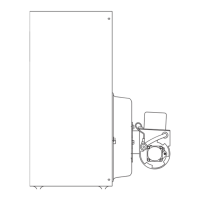OSB
Series 2 Oil-Fired Steam Boilers – Boiler Manual
Part Number 550-110-772/0816 5
2 Prepare boiler
Hydrostatic pressure test
1. Removesteampressuregaugefurnishedwithboiler.Install
water pressure gauge for test only. Be sure gauge can handle
test pressure.
2. Installairventintappingontopofboiler.
3. Remove pressure control and low water cutoff. Plug tappings.
4. Plug supply and return tappings.
5. Drain valve is already factory-installed.
6. Fillboiler.Ventallair.Pressuretestboilerat45-55psig.
Do not leave boiler unattended. Cold water fill can
expandanddamagecastiron,resultinginsevere
personal injury, death or substantial property damage.
7. Check for maintained gauge pressure for more than 10
minutes.Visuallycheckforleaksifgaugepressuredrops.
8. Drain boiler. Repair leaks if found.
Usingpetroleum-basedcompoundstorepairleaks
can damage system components, resulting in
property damage.
9. Retest boiler after repairing leaks.
10. Remove pressure gauge, air vent and plugs. Reinstall steam
pressure gauge, pressure control and low water cutoff
furnished with boiler.
Tankless heater, if used
1. Remove tankless heater knockout in left side of jacket panel.
2. Remove tankless heater cover plate and gasket.
3. Install newgasket and tankless heater over studs around
opening. Secure with 3/8” nuts.
4. Installtanklessheateroperatingcontrolintappingintankless
heater.Ifnotfurnished,useoperatingcontrolwithmaximum
10 °F differential.
Place boiler
The boiler contains ceramic fiber and fiberglass
materials.Usecarewhenhandlingthesematerials
per instructions on page 28 of this manual. Failure
to comply could result in severe personal injury.
1. Remove boiler from pallet.
Do not drop boiler or bump jacket or burner on floor
or pallet. Damage to boiler or burner can result.
Smallersizedboilersmaybetopheavy.Usecaution
when handling to avoid minor personal injury or
property damage.
2. Check level. Shim legs if needed.
3. Openburnermountingdoor.Verifythatchamberceramicliner
is securely in place on target wall, chamber floor and burner
door.Verifydoorsealisintactandinplace.Closeandsecurely
bolt the door.
4. Visuallycheck:
a. Flue collector hood seal.
b. Burner mounting door seal.
Obtaingas-tightsealtopreventpossibleue gas
leakage and carbon monoxideemissions, which
can lead to severe personal injury or death.
Failure to follow all instructions can result in flue gas
spillageandcarbonmonoxideemissions,causing
severe personal injury or death.
Inspect existing chimney before installing boiler.
Insufcientdraftcancause ue gas leakage and
carbon monoxide emissions. Failure to clean or
replace perforated pipe or tile lining and/or patch
mortar and joints can cause severe personal injury
or death.
• TheOSBboilersaredesignedtooperatewithanover-re
draft of -0.01” to -0.02” w.c. Proper draft for these oil boilers
maybeachievedusingeitheraconventionalchimney(natural
draft)orapowervent(sidewall)systemthathasbeenproperly
designed for use with oil-fired equipment. Power vent manu-
facturer’sinstructionsmustbefollowed.
• Useventmaterialapprovedbylocalcodesforoil-redburners.
Intheirabsence,referto:
• NFPA31,latestedition-InstallationofOil-BurningEquipment.
• NFPA21,latestedition-StandardforChimneys,Fireplaces,
VentsandSolidFuelBurningAppliances.
• NFPA211,latestedition-requireschimneytobelinedbefore
connected to boiler.
• Topreventdowndrafts,extendchimneyatleast3feetabove
highest point where it passes through roof and 2 feet higher
thananyportionofbuildingwithin10feet.Increasechimney
cross-sectionalareaandheightatleast4%per1,000feet
above sea level.
• Provide minimum clearances from vent(flue) pipe to
combustible material:
• Type“L”doublewallvent—6inchesminimum
• Singlewallvent—9inchesminimum
• Minimumchimneysizesshouldbeused.SeeTable3,page6.
Oversized chimneys, outside masonry chimneys
and/or derated inputs can result in condensation in
chimney.
3 Connect breeching
General venting requirements

